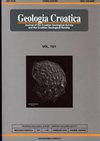匈牙利西南部希达斯的中新世(巴登晚期)微脊椎动物
IF 1.1
4区 地球科学
Q3 GEOLOGY
引用次数: 1
摘要
迄今为止,匈牙利西南部前潘诺尼亚中新世的陆生脊椎动物群尚未发表。2022 年,在梅切克山脉希达斯附近的一个废弃煤矿区,从中新世希达斯地层的石灰泥层中发掘出了一批微型无脊椎动物。本文介绍了其中的爬行动物和啮齿动物材料。化石发现指向巴登晚期的 MN 7+8 区,加上之前根据海洋软体动物群得出的结果,将该单元的年龄缩小到了约 13.5-13.3 Ma。两栖类和爬行类动物为水生、半水生或近水生形式。沉积特征和随附的淡水腹足类动物群表明了浅水池塘或掌状沉积环境。早先在希达斯地层中发现的鳄形目动物表明,当时正值中欧中新世温暖期结束之前的亚热带气候。在啮齿类动物中,鼯鼠、鼯鼠以及Democricetodon和Megacricetodon表明遗址周围存在潮湿的树栖植被。这些啮齿动物类群在匈牙利北部、罗马尼亚西部的中新世动物群以及德国南部和瑞士的上淡水摩拉斯动物群中非常有名。啮齿动物材料没有显示出海岛动物群的特征,例如巨型化或地方性。因此,尽管该地区的共生古地理被描述为中帕拉泰西的一个群岛,梅切克山是其中的一个岛屿,但该地区肯定与潘诺尼亚盆地的北部和东部有生态联系,群岛内的海洋区域并没有对微小脊椎动物的分布形成障碍。该走廊可能位于梅切克山的东北部,穿过匈牙利中部高耸的基底岩块。本文章由计算机程序翻译,如有差异,请以英文原文为准。
Middle Miocene (Late Badenian) microvertebrates from Hidas, SW Hungary
Up to the present, no terrestrial vertebrate fauna has been published from the pre-Pannonian Miocene of SW Hungary. In 2022 a microvertebrate assemblage was unearthed from a lime mud bed of the Middle Miocene Hidas Formation, in an abandoned coal mining field close to Hidas in the Mecsek Mts. The herpetofauna and the rodent material are described here. Fossil findings point to the Late Badenian MN 7+8 Zone, which, together with the earlier results based on the marine mollusc fauna, narrows the age of the unit to ~13.5–13.3 Ma. The amphibians and reptiles are aquatic, semiaquatic or periaquatic forms. Sedimentary features and the accompanying freshwater gastropod fauna are indicative of a shallow pond or a paludal depositional environment. Crocodylian finds reported earlier from the Hidas Formation indicate a subtropical climate, just before the end of the Miocene warm period in Central Europe. Among the rodents, glirids and flying squirrels as well as Democricetodon and Megacricetodon indicate the presence of humid arboreal vegetation around the site. The rodent taxa are well known from the Middle Miocene faunas of northern Hungary, western Romania and from the Upper Freshwater Molasse of southern Germany and Switzerland. The rodent material does not show characteristics of an insular fauna, e.g. gigantism or endemism. Consequently, although the coeval palaeogeography of the region has been described as an archipelago in the Central Paratethys, with the Mecsek Mts. being one of the islands, the area must have had ecological connections towards the northern and eastern parts of the Pannonian Basin, and the marine areas within the archipelago did not form a barrier against the distribution of microvertebrates. The corridor could have been located towards the NE from the Mecsek Mts., across the elevated basement blocks of central Hungary.
求助全文
通过发布文献求助,成功后即可免费获取论文全文。
去求助
来源期刊

Geologia Croatica
GEOSCIENCES, MULTIDISCIPLINARY-
CiteScore
2.90
自引率
23.10%
发文量
35
审稿时长
>12 weeks
期刊介绍:
Geologia Croatica welcomes original scientific papers dealing with diverse aspects of geology and geological engineering, the history of the Earth, and the physical changes that the Earth has undergone or it is undergoing. The Journal covers a wide spectrum of geology disciplines (palaeontology, stratigraphy, mineralogy, sedimentology, petrology, geochemistry, structural geology, karstology, hydrogeology and engineering geology) including pedogenesis, petroleum geology and environmental geology.
Papers especially concerning the Pannonian Basin, Dinarides, the Adriatic/Mediterranean region, as well as notes and reviews interesting to a wider audience (e.g. review papers, book reviews, and notes) are welcome.
 求助内容:
求助内容: 应助结果提醒方式:
应助结果提醒方式:


